Forest biomass carbon storage from multiple inventories over the past 30 years in Gansu Province,China:implications from the age structure of major forest types
••••
ORIGINAL PAPER
Forest biomass carbon storage from multiple inventories over the past 30 years in Gansu Province,China:implications from the age structure of major forest types
Jinhong Guan1,5•Huanshui Zhou3•Lei Deng4•Jianguo Zhang1,5•Sheng Du1,2
©Northeast Forestry University and Springer-Verlag Berlin Heidelberg 2015
We used the forest inventory data of Gansu Province,China to quantify carbon storage and carbon density changesby regionalforestcoverand by typicalforest types in 1979–2006.Total forest area increased from 1.77×106ha in 1979 to 2.32×106ha in 2006,and the forest carbon storage,estimated by the continuous biomass expansion factor method,increased from 83.14 to 100.66 Tg,equivalent to a carbon accumulation rate of 0.0071 Tg peryearduring the period.Mean carbon densities were 44.83–48.50 t ha-1and the values decreased slightly over the time period.Natural forests generated greater carbon storage and density than did plantations.By regression analysis,forest stand age was an important parameter in carbon density studies.We developed various regression equations between carbon density and stand age for major types of natural forests and plantations in the region.Our results can be used for proper selection of re-forestation speciesand eff i cientmanagementofyoung and middle-aged forests,offering great potential for future carbon sequestration,especially in arid and semi-arid regions.
Age class⋅Carbon density⋅Forest carbon storage⋅Forest inventory data⋅Gansu Province⋅Reforestation
Introduction
Globally,forests cover about 4.1×109ha,approximately 38%of land area,accounting for 76–98%of the aboveground,and 40%of the below-ground global organic carbon(Cao and Woodward 1998;Dixon 1994).Forest ecosystems are critical to global terrestrial carbon cycling and storage.Human activities and/or natural events,such as land management(Houghton 2003;Hunter 2001),air pollution(Canadell et al.2007a),insect attacks(Kurz and Apps 1999),N deposition(Vetter et al.2005),and climate change,have a noticeable effect on carbon storage.The net balance of carbon exchange,due to combinations of events and activities,has resulted in forests acting as either carbon sources or carbon sinks(Noble and Dirzo 1997;Wang et al. 2007).Assessing carbon storage at large scales,either global,national and/or regional,has been a focus on carbon cycling for the past several decades(Brown and Lugo 1982;Fang et al.2001;Zhang et al.2012).Consequently, estimating the spatial and temporal variations in carbon storage has been considered of great importance for understanding the impacts of climate change and humanactivities(King et al.1997;Ni 2001;Parks and Bernier 2010;Zaehle et al.2007).
China is a signatory to the Kyoto Protocol and the United Nations Framework Convention on Climate Change,and has planned to reduce the intensity of CO2emissions per unit of GDP in 2020 by 40–45%compared with the level of 2005(Xinhua 2009).To achieve this target,China has launched a series of nationwide afforestation and reforestation projects.Such approaches are inextricably linked to the evaluation of carbon storage and f l ux.Species and stand age structure,inevitably,are the prominent determinants of timber production and carbon storage(Garcia-Gonzalo et al.2007;Ren et al.2011; Schulze et al.2000)since young stands acquire carbon from dead materials and litterfall(Kashian et al.2006; Wang et al.2007).Furthermore,stand age can provide clues about past disturbances while aiding assessment of carbon storage dynamics(Hicke et al.2007).Due to intensive deforestation and reforestation over the last century,stand age structure has been signif i cantly modif i ed in China,especially in the western region.Therefore,successive inventories of the forest resources can provide a scientif i c basis for assessing the vegetation carbon storage and possible drivers affecting the dynamics of carbon storage(Ren et al.2011;Shi et al.2011).
Since China is one of the largest countries with a wide north–south gradient in temperature and a west-east gradient in precipitation,ecosystem carbon storage can be studied on either large-or small-scale climatic and geographic units(Hou 1983;Wang et al.2007).China contains diverse ecosystems,including all major forest types of the northern hemisphere,from boreal forests in the north to evergreen tropical forests in the south(Hou 1983; Houghton and Hackler 2003;Li 2004).Forest inventory data(FID)in China is a valuable tool in monitoring the macro-changes of forest resources and biomass,as it includes natural and anthropogenic impacts on forests at regional and national levels,and has been conducted every 5 years for more than 30 years.The inventory is carried out by specially-designed standards formulated by the State Forestry Administration,focusing on the area and volume of each forest stand type(Lei et al.2009;Liu and Cossalter 2006).
Gansu Province in northwest China covers about 4.7% of the country,ranking it the 7th largest of 34 administrative divisions of China.Compared with the eastern and southern regions,Gansu is ecologically fragile with large areas of arid and semiarid land.There are 2.32×106ha of forest,approximately 5.11%of land area,and a total timber volume of 1.94×108m3according to the recent National Forest Inventory(Fig.1).Forest cover has been increasing due to implementation of national projects,such as the‘Natural Forest Protection’and‘Grain-for-Green’’(converting cropland to forest or grassland).During the past 3 decades,forest area and volume in Gansu Province have increased by 31.39 and 17.15%,respectively. Although plantations contribute only a small fraction to global forest carbon(1.4×108ha of current forests,3.8% of the total(FAO 2006))their potential capacity for accumulating carbon and mitigating climate change in the future has been recognized(Canadell et al.2007b;Pregitzer and Euskirchen 2004).Therefore,an assessment of carbon dynamics is urgently needed for properly evaluating and predicting present and future capacity for carbon sequestration in forests of each region(Chen et al.2009). Since forest area has been increasing in the province,we hypothesized that forest carbon storage also increased. Given that forest age is an important determinant of carbon density(Pan et al.2004;Xu et al.2010),we predicted that forest age structure strongly affect the changing trend of carbon density and storage.
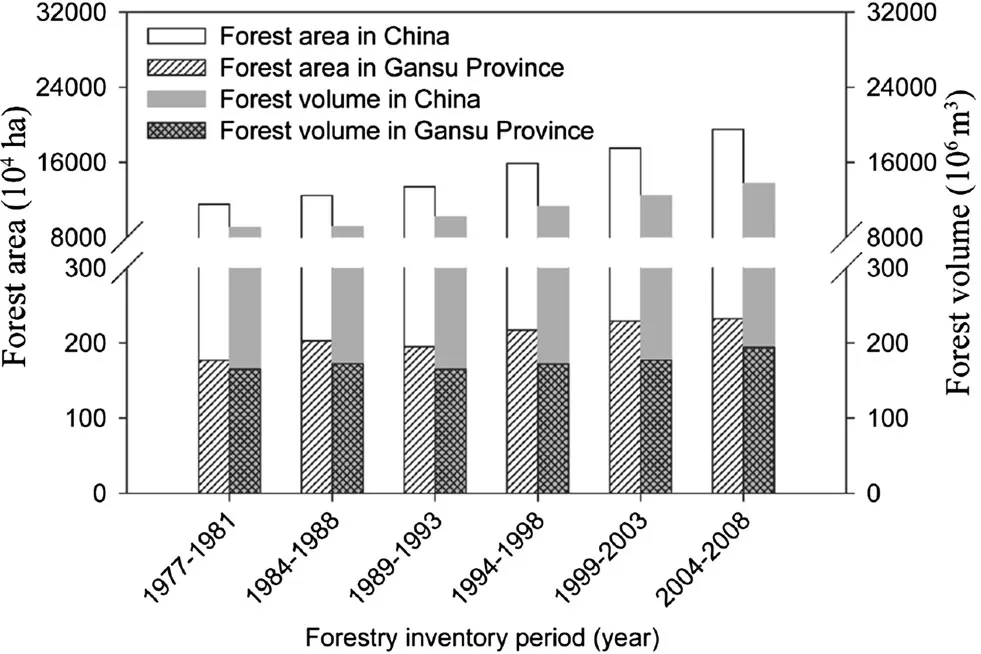
Fig.1 Changes in forest area and forest volume in China and Gansu Province since 1977.Each period refers to a working time-span of the national forest inventory.The corresponding surveys in Gansu Province were f i nished in 1979,1988,1991,1996,2001,and 2006
Based on multiple FID from 1979 to 2006,we aimed to estimate the status of carbon storage and density and their dynamic changes within Gansu Province,to quantify the dynamics of carbon allocation in both natural forests and plantations,and to determine the effect of forest type, forest age,and forest origin on forest carbon density.
Materials and methods
Study area
Gansu Province is located in the upper reaches of the Yellow River in northwest China,at 32°11′–42°57′N and 92°13′–108°46′E,with a total geographic area of 4.54×105km2(Fig.2).The climate is categorized as continental monsoon,with long cold winters and shortwarm summers.Most of the precipitation is concentrated in summer with average annual totals of 40 mm in the northwestern arid desert and 540 mm in the southern subhumid forest.Average temperatures ranged from 0 to 15°C,according to recent 50-year data from meteorological stations(CMDSSS).Because of the uneven precipitation distribution(a minimum of 30 mm to a maximum of 860 mm),ecosystems change from forest to steppe to desert from southeast to northwest Gansu.The geographic features are narrow and long,going from southeast to northwest,with an interlaced distribution of mountain, plateau,plain,valley and desert.More than 70%of the area consists of mountains and plateau and most elevations are over 1000 m.Forest types include sub-tropical broadleaved evergreen and deciduous forest,warm-temperate deciduous forest,cold-temperate deciduous forest,coldtemperate coniferous forest,and coniferous and broadleaved mixed forest(GFEB 1998).
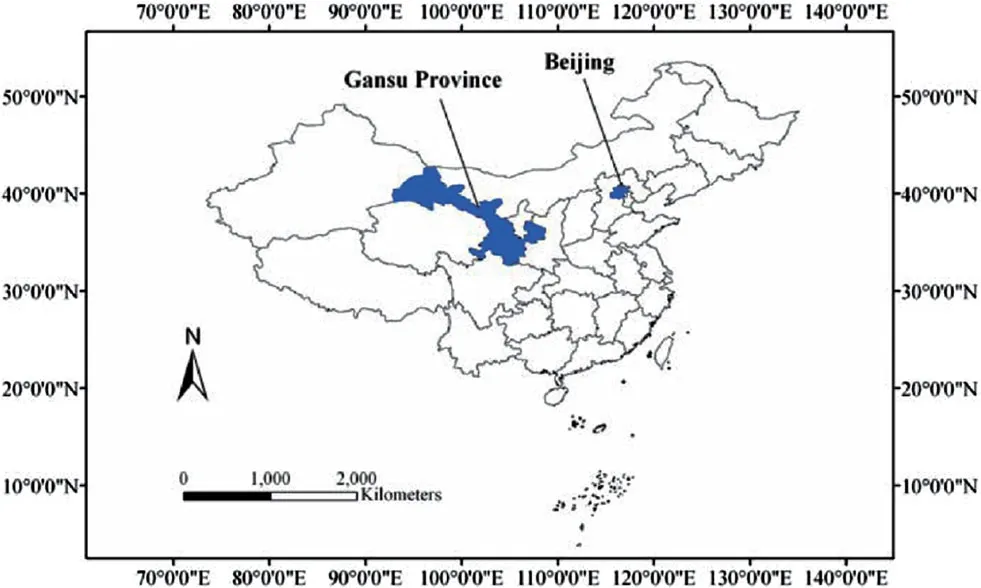
Fig.2 Map of China showing the location of Gansu Province
Data sources
The State Forestry Administration has conducted 6–7 systematic surveys in most provinces since the 1970s(Lei et al. 2009).The f i rst survey in Gansu Province was conducted in 1979 and the 6th survey was f i nished in 2006.In the inventories,detailed information about forest type(species and origin),area,volume,extent,age class,forestry program type(e.g.shelter forest,timber production forest,fuelwood forest,special purpose forest)and ecological status is collected in systematically-distributed permanent sample plots (each with an area of 800 m2in Gansu Province).On a nationwide scale,forests include three large categories,i.e. general forest stands(both natural and planted forests), economic forests(plantations which are used for the production of fruits,edible oils,medicine,f l avorings and industrial raw materials),and bamboo forests.As few economic and bamboo forests occur in Gansu Province,the forest inventory data in this study only cover general forest stands,including natural forests and plantations.
In 1979,a total of 6855 sample plots were surveyed,and sample plot numbers increased in later surveys.There were 17,702 permanent sample plots in the surveys of 2001 and 2006.In these plots,we measured the height and diameter at breast height(DBH)of all trees with DBH>5 cm,and calculated the stem volume of each measured tree by a volume table in accordance with species and region(FAC 1977).Stand timber volume of each plot was calculated by adding the volume of all individual trees within a plot.The differences in forest types and age classes were not separated in the 1979 inventory.Natural forests and plantations were separately recorded from the inventory of 1988.Since 1991,all forests have been recorded by category of origin and age.To obtain relatively precise biomass and carbon estimates,we used the data from the later 4 inventories for most of the analyses in our study.
Def i ning forest age class
The age classes of dominant trees recorded in the inventory are based on national guidelines of forest resource surveys (MOF 1982).Five age classes were used to classify forest age:young forest,middle-aged forest,pre-mature forest, mature forest and over-mature forest.The full def i nition of each age class with respect to different species is shown in Table 1.
Forest biomass estimation
We used the consistent function of stem volume,i.e.,the continuous biomass expansion factor(BEF)method,which is widely recommended as it uses timber volumes that are closely related to forest biomass and it involves forest age, density,site and other factors.(Brown and Lugo 1982; Fang et al.2001;Guo et al.2010).The relationship between biomass and stem volume of a specif i c forest type (species group)can be described as:

where,Bis the total(including above and below ground) dry biomass per hectare(t ha-1),Vis the stem volume per hectare(m3ha-1),andaandbare parameters which are constants for a specif i c forest type when stand volume is large enough.For estimating provincial biomass of all forests,the calculation can be expressed as:

In the calculation of forest biomass using FID,forests were categorized into 21 species groups according todominant species.Parameters of forest volume-biomass for the tree species were developed by Fang et al.(2001).For tree species with unknown parameters,biomass estimation was based on the parameters of the other known species according to their morphological similarity.

Table 1 Criteria of forest age classif i cation for major species in Gansu Province,China
Forest carbon storage and carbon density
The calculated total biomass was converted into forest vegetation carbon storage by multiplying biomass by percentage of carbon content.Carbon content can vary from 45 to 55%of total biomass,differing between tree components(e.g.stems,branches,leaves and roots),species, age,and community structure of forest types(Brown and Lugo 1984;Fang et al.2001;Potter et al.2008).We used the generally-accepted average carbon content of 50% (Fang et al.2001;Karjalainen 1996).Carbon density of a forest type is the ratio of its total carbon storage to its area and varies according to forest type,area and age class.
Because the def i nition of forest in China’s national inventories has been changed from a canopy density of 30–20%since 1994,forest areas calculated in earlier inventories can be lower,especially for young plantations that may contain stands with density of 20–30%.In order to compare data before and after 1994,we used a linear model constructed by Fang et al.(2007)to calibrate the data of forest area and carbon storage,and the corresponding forest carbon density was calculated using the same criteria.
Results
Dynamics in forest carbon storage
The provincial total amount of forest carbon storage increased from 83.14 to 100.66 Tg,while forest carbon density decreased from 47.29 to 45.00 t ha-1from 1979 to 2006(Fig.3).Though the forest carbon storage showed a mean carbon accumulation rate of 0.0071 Tg per year during the whole period,there was a decrease that occurred in 1988–1991.A rapid increase occurred after 1991 with a mean carbon accumulation rate of 0.0123 Tg per year by 2006.
Natural forests and plantations showed remarkable differences in both the amounts and trends of forest carbon storage(Fig.4).Natural forests accounted for 68.14 and 79.98%of the total forest area and carbon storage, respectively,according to the recent inventory.The highest proportion of carbon storage has always been in natural forests and followed a pattern similar to that of total carbon storage as documented by inventories over time.Plantations showed lower carbon density than natural forests. Carbon storage in plantations increased in a f l uctuating pattern since 1988.
Due to afforestation and reforestation,there have been two large increases of 25.98×104and 22.55×104ha in forest area in 1979–1988 and 1991–1996,leading to jumps in forest carbon storage of 7.05 and 7.83 Tg,respectively. Compared with the baseline that was set by the f i rstinventory,forest carbon storage increased by 17.52 Tg in the whole province.
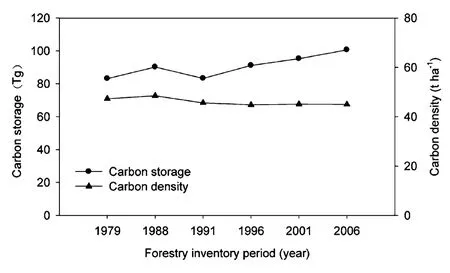
Fig.3 Changes in forest carbon storage and carbon density in Gansu Province since 1979
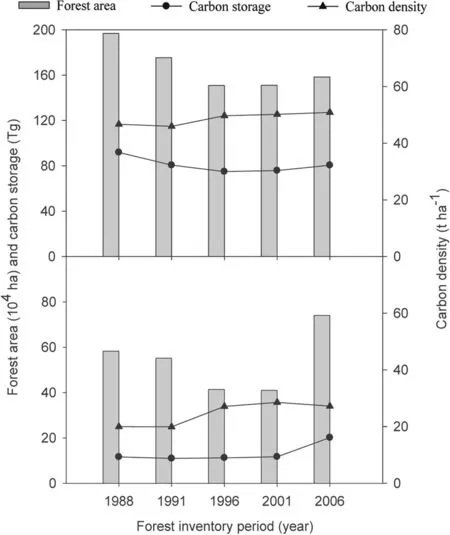
Fig.4 Changes in forest area and carbon storage of natural forests and plantations in Gansu Province since 1988(natural forests and plantations were not separated in the inventory in 1979)
Carbon storage distribution by forest age class
Forest carbon storage was greatly affected by the age class and the contributions by different age classes were different between natural forests and plantations,coinciding with the variations in their areal extent(Fig.5).The middleaged forest class contributed the most to carbon storage in natural forests,whereas for plantations,both young and middle-aged forest classes contributed most to carbon storage.Apparently,afforestation and reforestation programs affected age structure and carbon storage proportions of plantations.Natural forests maintained relatively stable proportions of age classes although the general trend of carbon storage was an increase over the study period.
Carbon storage and carbon density in typical forest types
The dominant tree species of major forests in Gansu Province can be def i ned asAbies spandPiceaspp.,Pinus tabuliformis,Quercusspp.,andPopulusspp.These four groups of tree species accounted for 40%of the total forest area,and their carbon storage accounted for 50%of the total according the recent FID.We selected these four forest types and analyzed their carbon storage dynamics over the period 1979–2006(Fig.6).Over the study period, the mean area,carbon storage and carbon density ofAbies/ Piceawere consistantly higher than for the other three types.The carbon density of 4 forest types showed f l uctuating increases over the whole period.The data conf i rm that theAbies/Piceaforest was logged extensively before the implementation of Natural Forest Protection in 1990s.
Relationship between forest carbon density and age class
Regression analyses showed forest carbon density was signif i cantly correlated with stand age(Figs.7,8).Between 4 types of forests,Pinus,Quercus,andPopulusshowed quadratic regressions,whereasAbies/Piceashowed a positive linear regression,or the ascending phase of a parabola. Separating the data into natural(Fig.7)and planted(Fig.8) forests revealed differences in the regression equations.For the forest types dominated byPinusandPopulus,natural forests reached their maximum value of carbon density at around the age of 90 and 70 years,respectively,whereas, plantations reached a maximum at around 40 and 25 years, respectively.Abies/Piceaforests showed gradual increases in carbon density with increasing age,without reaching their maxima at the ages reached during the study.In Gansu Province,allQuercusforests were natural and maximum carbon density was reached at around 90 years according to the f i tted equations.
Discussion
Characteristics of forest carbon storage and carbon density
Total forest carbon storage in Gansu Province decreased from 90.19 Tg in 1988 to 83.31 Tg in 1991,and then increased to 100.66 Tg in 2006,most likely due to changes in land use.There have been studies suggesting that growth of human population and economic policy changes during the past decades in China resulted in signif i cant changes in land use,forest volumes,and,accordingly,in carbon storage.The construction of Three-North Shelterbelt in the north,northeast and northwest of China was started in the late 1970s,resulting in a small increase in plantations in Gansu Province.The implementation of Natural Forest Protection and Grain-for-Green projects in the late 1990s totally banned deforestation and resulted in conversion of much farmland back to forest.The increasing trend of carbon accumulation shown in the later inventories demonstrated the effects of reforestation programs.
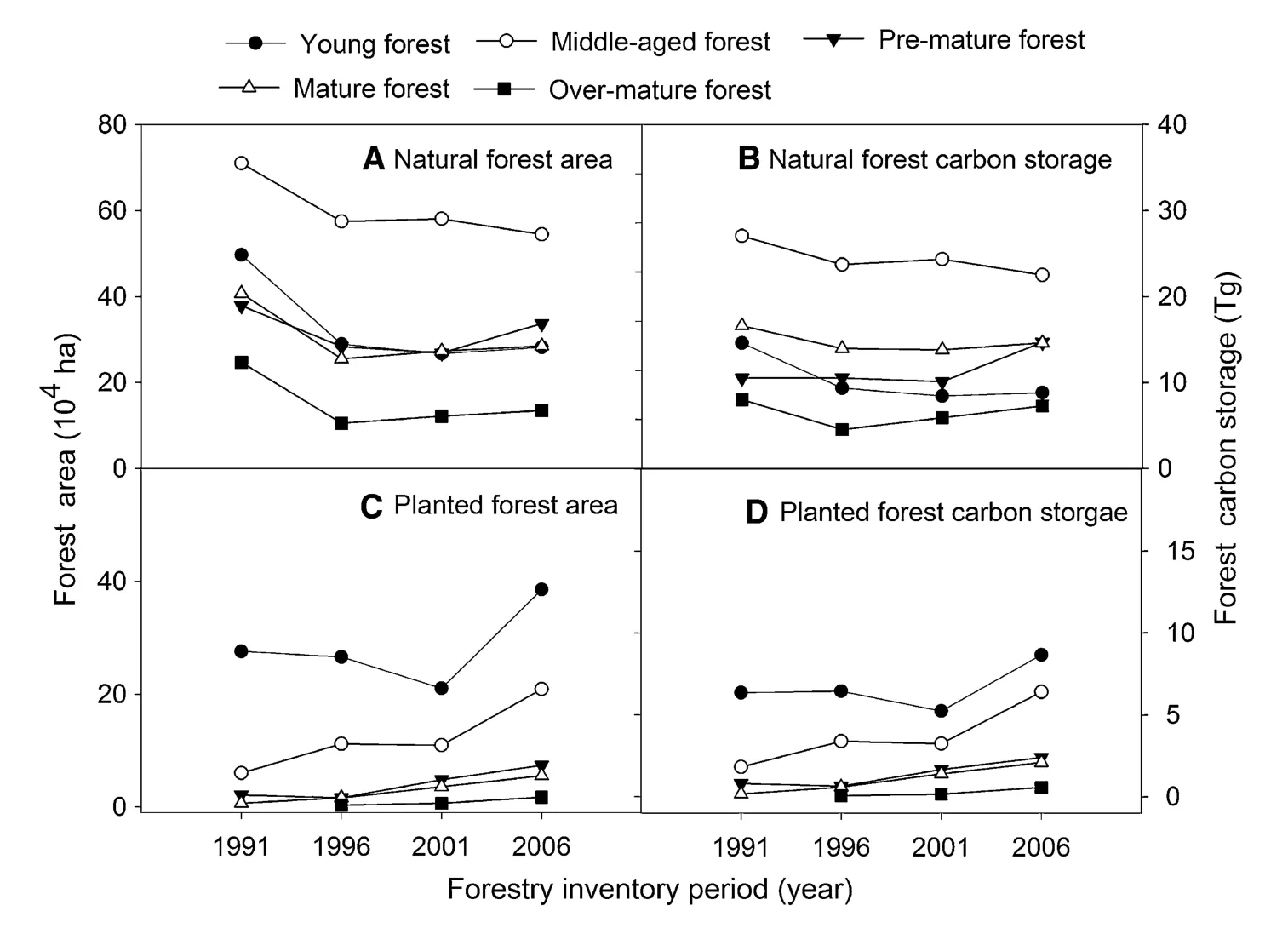
Fig.5 Changes in forest area and forest carbon storage of different age groups in natural forests and plantations since 1991(forests of different age classes were not separated in the inventories in 1979 and 1988)
Plantations contributed more to the temporal changes of forest cover in the province.With an increasing proportion of mature forest,carbon density of plantations,in addition to carbon storage,is expected to increase.This suggests that plantations will be a considerable sink for carbon sequestration in the next decade.However,given that the distribution of plantations covers various climatic and geographic sites in Gansu Province,the average potential for carbon sequestration in plantations should be much lower than in natural forests.Over our study period,carbon density of natural forests was invariably 1.75 to 2.13 times higher than for plantations.This is mainly because forest types in this province are predominantly high biomass subalpine coniferous natural forests,which account for about 44%of the area and 66%of the volume of the whole province.Furthermore,the higher carbon density in natural forest is consistent with the national case(Fang and Chen 2001).In northwestern China,with many areas of arid and semi-arid land,forest types and distributions differ from those in other regions,resulting in lower total carbon storage but higher carbon densities(Wang et al.2002, 2001).
Compared with other northwestern provinces,carbon density over the three decades in this study was lower than the estimates for Xinjiang(65.34 t ha-1)and Qinghai (51.01 t ha-1),but was higher than reported for Shaanxi (40.51 t ha-1)and Ningxia(37.4 t ha-1)(Fang and Chen 2001).Meanwhile,carbon density in Gansu was higher than the nation-wide average(Fang et al.2001),which can be attributed to the large proportion of subalpine coniferous forests with high biomass.
Species difference in the relationship between forest age class and carbon density
For different forest types and species,forest ages that correspond to a stage of maturity are not equal.For example,it takes more than 120 years to reach maturity for naturalAbiesforests;however,naturalPinusforests only require 60 years to reach maturity.The productivity dynamics within a generation are thus specif i c to forest types and dominant species.For most forest types,forest carbon density increases with forest age(Yang and Guan 2008).Analyses in this study support this general trend (Figs.7,8).However,differences in the regressive relationships were also detected among species and between natural forests and plantations.Abies/PiceaandQuercusforests represented the largest areas of natural coniferous and broadleaved forests in the province,and the former constituted a major proportion of regional carbon storage. The estimated ages when these two types of forest reach their highest carbon density are more than 160 years and about 100 years,respectively(Fig.7A,D).Our analyses also showed that the maximum carbon densities of these natural forests can be more than 100 and 60 t ha-1, respectively.These results suggest that the present composition of age structures for both types has considerable potential for carbon accumulation.The other two types ofnatural coniferous and broadleaved forests,PinusandPopulus,though accounting for smaller proportions of overall forest distribution,also showed increasing trends in carbon storage with respect to their carbon density peaks (Fig.7B,C).

Fig.6 Changes in forest area,carbon storage,and carbon density of four typical forests in Gansu Province since 1979
Dynamics of carbon density for plantations also varied with age.As plantations have shorter life spans and lower peaks of carbon density than natural forests of corresponding species,their contribution to the regional carbon storage is also lower.Nevertheless,the two types of coniferous plantations still have considerable potential for carbon accumulation(Fig.8A,B).
The area and carbon storage in different forest types and age classes ref l ect the major characteristics of regional forest distribution and trends.According to the recent FID, middle-aged,premature and mature classes accounted for 74.92%of natural forest carbon storage,whereas 74.82% of plantation carbon storage was stored in young and middle-aged classes(Fig.5).This suggests that prohibition of deforestation and management of plantations play crucial roles in carbon accumulation in regional forests.The contribution of age classes might be different in other regions due to different land-use histories.Reports for several southern regions showed that large proportions of carbon storage were in young and middle-aged forests,for example 76.32%in Pearl River Delta,71.6%in Hainan Province(Yang and Guan 2008),65%in Yunnan Province (Pei and Li 2012),and 81.19%in Fujian Province(Ren et al.2011).However,the nationwide average showed that carbon storage was mainly distributed in middle-aged and mature forests that accounted for 85.3%of the total(Fang and Chen 2001;Yang and Guan 2008).This suggests large variations in forest types and carbon storage distribution throughout the country based on differing natural conditions and management histories.
Potential of forest carbon storage in the province
It is commonly expected that increasing CO2emissions from fossil fuel consumption will be partly offset by afforestation and reforestation(Steffen et al.1998).Several researchers estimated that about 0.3 Pg C has been sequestrated by forest plantations in China since the mid-1970s and this greatly contributed to global terrestrial carbon sinks(Fang et al.2001,Zhang et al.2000).Hence, with about 38.54×104ha of young plantations,this region has considerable potential to accumulate additional biomass.Baishya et al.(2009)reported that plantation forests of sal(Shorea robusta)in northeastern India had higher aboveground biomass(406.4 t ha-1)than the natural tropical semi-evergreen forests(323.9 t ha-1),with carbon density approximating 203 and 162 t ha-1, respectively.He suggested that plantation forests had an advantage over the natural forest because of better silvicultural practices(Baishya et al.2009).In our study region, forest productivity is generally at a magnitude of tens of t ha-1,with plantations 50%lower than natural forests (Figs.7,8).This corresponds with the nature of many arid and semiarid areas in the province,and the general distribution of natural forests in sub-humid mountainous areas. Nevertheless,if scientif i c management is applied to young and middle-aged forests,they may play important roles in mitigating increasing CO2concentration in the atmosphere in the region.
This study focused on the vegetation carbon storage dynamics without inclusion of soil carbon sequestration. Soil carbon generally accounts for two thirds of the total carbon storage in a forest(Dixon 1994).Chronosequence studies showed that converting arable land to forestresulted in increases in soil carbon storage with stand age, especially in the upper soil layers(Johnson 1992;Lugo et al.1986;Wilde 1964).Due to increasing areas of plantations on abandoned farmland resulted from national ecological projects in recent years,it is expected that not only vegetation biomass but also soil organic carbon in young and middle-aged forests will contribute considerably to carbon sequestration.Proper forest management strategies are needed in order to promote either the accumulation of soil carbon storage or forest ecosystem productivity.
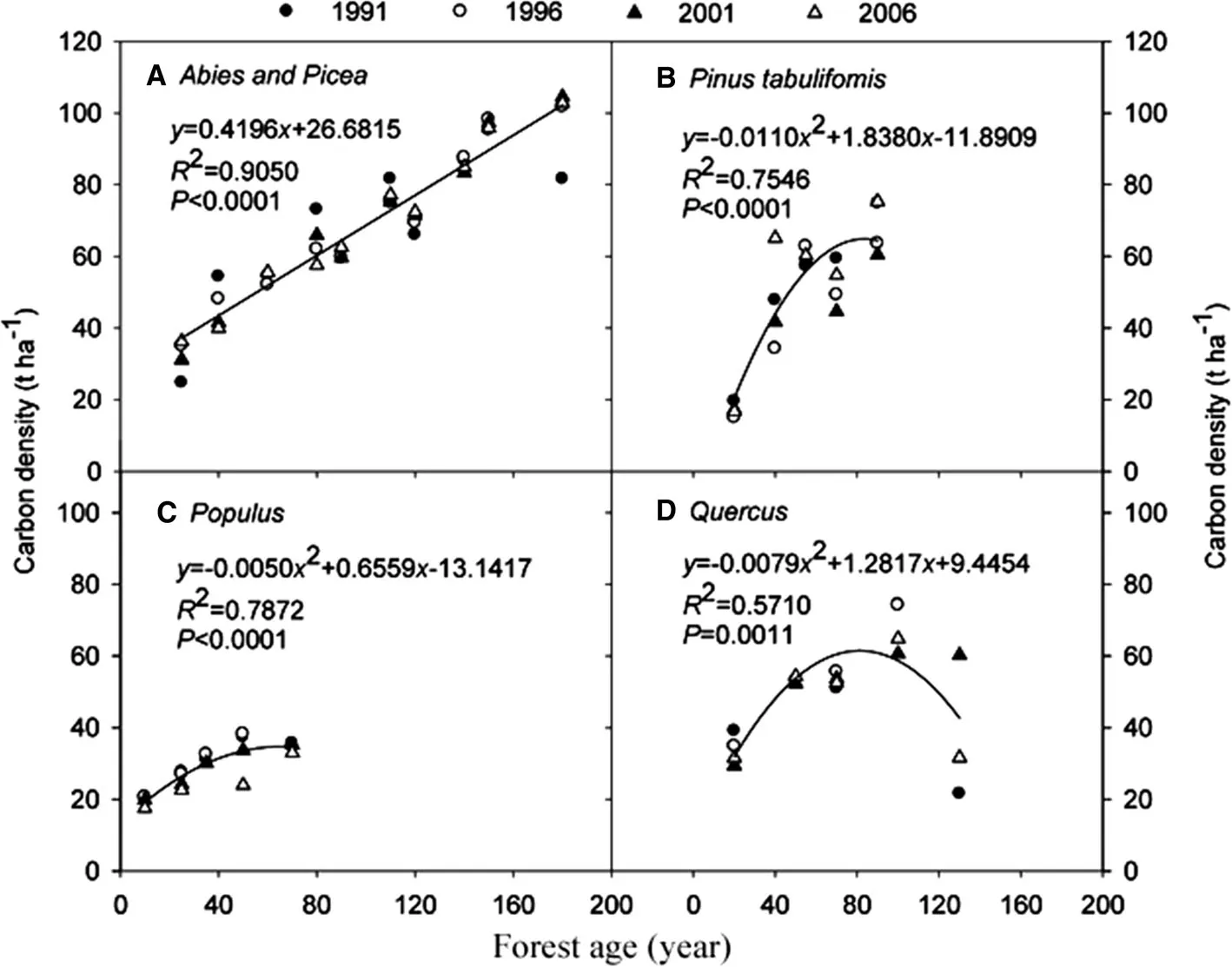
Fig.7 Relationship between forest carbon density and forest age for four natural typical forests in Gansu Province
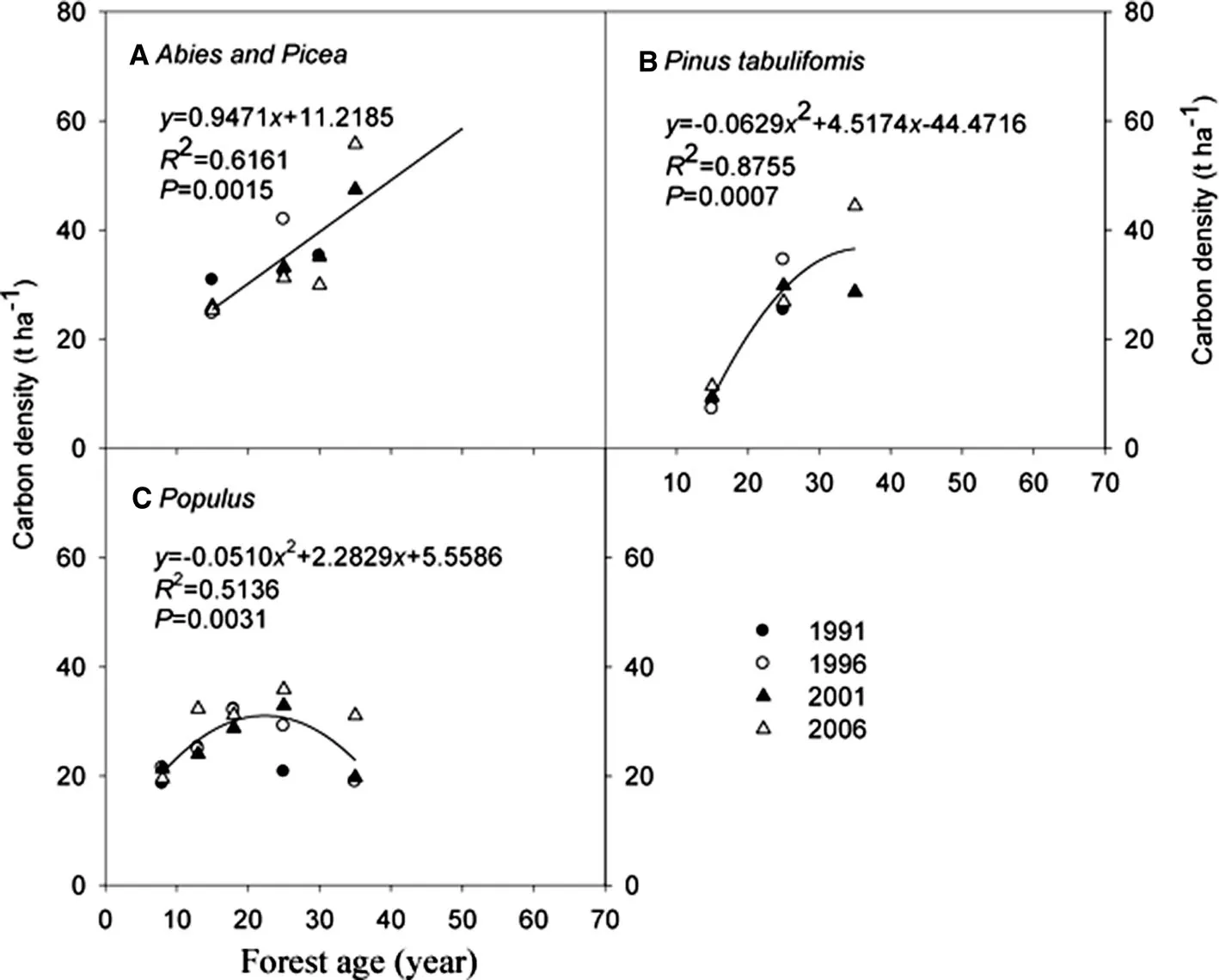
Fig.8 Relationship between forest carbon density and forest age for three typical plantations in Gansu Province(There are no plantation Quercus forests in Gansu Province)
Uncertainties in estimation of biomass and carbon storage based on FID
Several uncertainties and errors in estimation of biomass and carbon storage can result from this inventory-based method.Due to varying geographical conditions,the same species at different sites frequently show conspicuously different heights and diameters.This may cause bias in the estimated forest biomass of each species/age class(Zhao and Zhou 2005).Another problem is that trees with DBH<5 cm were excluded in the inventory,which leads to an uncertainty in approaches to analyzing carbon storage potential(i.e.,carbon sink in the future),especially for young forests.Biomass of belowground,shrub,grass,litter and dead wood of understory were also excluded.Some estimates showed that downed and dead wood can be 14% of the total ecosystem carbon storage in US forest and that litter can be 5%in global forest carbon storage(Pan et al. 2011,Woodall et al.2008).In the future,inventories for carbon storage monitoring should be expanded to include both above-and below-ground carbon because both are important contributors to total carbon dynamics.
Conclusion and management implication
The marked increase in carbon storage in Gansu Province over the period 1979–2006 provides evidence that some national ecological programs have made a positive contribution to carbon sequestration.Considering the large proportions of young and middle-aged forests in the province,age structure effects on ecosystem carbon sequestration will be more prominent in the near future,especially if effective strategies are applied.The dynamics of forest productivity and carbon density during the life cycle of a stand varies by forest type/species and origin(natural or planted).Natural forests,coniferous forests in particular, are major forest types in the region and have a relatively high carbon densities and long life-spans.These forests have considerable potential for carbon accumulation due to their carbon density peaks at older ages.With rapid increases in area,plantations are also making an increasing contribution to regional carbon storage,especially young plantations established during implementation of various ecological programs.On the other hand,for higher precision of regional carbon storage estimates,it is necessary to collect more samples that cover a large range of age classes and site conditions.Moreover,future surveys should cover every component within the ecosystem,including more vegetation layers and the soil.In addition,remote sensing technology may also contribute to the survey of forest resources.
The present study not only provides a provincial summary of forest carbon storage over the past 30 years but also reveals the differences in age-related changes of carbon density among major forest types and species.The results suggest that future forest management should emphasize the selection of reforestation species and proper silvicultural practice with respect to the development stage so that carbon sequestration potentials can be maximized.
AcknowledgmentsThis research was supported by the Chinese Academy of Sciences through the Strategic Priority Research Program(XDA05050202).The forest inventory database of the State Forestry Administration of China is gratefully acknowledged.
Baishya R,Barik SK,Upadhaya K(2009)Distribution pattern of aboveground biomass in natural and plantation forests of humid tropics in northeast India.Trop Ecol 50:295–304
Brown S,Lugo AE(1982)The storage and production of organic matter in tropical forests and their role in the global carbon cycle.Biotropica 14:161–187
Brown S,Lugo AE(1984)Biomass of tropical forests-a new estimate based on forest volume.Science 223:1290–1293
Canadell JG,Kirschbaum MUF,Kurz WA,Sanz MJ,Schlamadinger B,Yamagata Y(2007a)Factoring out natural and indirect human effects on terrestrial carbon sources and sinks.Environ Sci Policy 10:370–384
Canadell JG,Le Quere C,Raupach MR,Field CB,Buitenhuis ET, Ciais P,Conway TJ,Gillett NP,Houghton RA,Marland G (2007b)Contributions to accelerating atmospheric CO2growth from economic activity,carbon intensity,and eff i ciency of natural sinks.Proc Natl Acad Sci USA 104:18866–18870
Cao MK,Woodward FI(1998)Net primary and ecosystem production and carbon stocks of terrestrial ecosystems and their responses to climate change.Global Change Biol 4:185–198
Chen XG,Zhang XQ,Zhang YP,Wan CB(2009)Carbon sequestration potential of the stands under the Grain for Green Program in Yunnan Province,China.For Ecol Manag 258:199–206
CMDSSS.http://cdc.cma.gov.cn/home.do.CMDSSS(China Meteorological Data Sharing Service System)
Dixon RK(1994)Carbon pools and f l ux of global forest ecosystem. Science 263:185–190
FAC(1977)Tree volume tables(National standard#LY208-77). Beijing.FAC(Forestry Administration of China),Forestry Administration of China
Fang JY,Chen AP(2001)Dynamic forest biomass carbon pools in China and their signif i cance.Acta Botan Sin 43:967–973(in Chinese)
Fang JY,Chen AP,Peng CH,Zhao SQ,Ci L(2001)Changes in forest biomass carbon storage in China between 1949 and 1998. Science 292:2320–2322
Fang JY,Guo ZD,Piao SL,Chen AP(2007)Terrestrial vegetation carbon sinks in China,1981–2000.Science in China Ser D-Earth Sci 50:1341–1350
FAO(2006)Global forest resource assessments(2005)Progress towards sustainable forest management.FAO Forestry,Rome
Garcia-Gonzalo J,Peltola H,Gerendiain AZ,Kellomaki S(2007) Impacts of forest landscape structure and management on timber production and carbon stocks in the boreal forest ecosystem under changing climate.For Ecol Manag 241:243–257
GFEB(1998)Gansu forest.Department of Forestry of Gansu Province,GFEB(Gansu Forest Editorial Board),Lanzhou
Guo ZD,Fang JY,Pan YD,Birdsey R(2010)Inventory-based estimates of forest biomass carbon stocks in China:a comparison of three methods.For Ecol Manag 259:1225–1231
Hicke JA,Jenkins JC,Ojima DS,Ducey M(2007)Spatial patterns of forest characteristics in the western United States derived from inventories.Ecol Appl 17:2387–2402
Hou HY(1983)Vegetation of China with reference to its geographical distribution.Ann Mo Bot Gard 70:509–549
Houghton RA(2003)Revised estimates of the annual net f l ux of carbon to the atmosphere from changes in land use and land management 1850–2000.Tellus B 55:378–390
Houghton RA,Hackler JL(2003)Sources and sinks of carbon from land-use change in China.Glob Biogeochem Cycles 17:1034
Hunter I(2001)Above ground biomass and nutrient uptake of three tree species(Eucalyptus camaldulensis,Eucalyptus grandisandDalbergia sissoo)as affected by irrigation and fertiliser,at 3 years of age,in southern India.For Ecol Manag 144:189–199
Johnson DW(1992)Effect of forest management on soil carbon storage.Water Air Soil Pollut 64:83–120
Karjalainen T(1996)The carbon sequestration potential of unmanaged forest stands in Finland under changing climatic conditions. Biomass Bioenergy 10:313–329
Kashian DM,Romme WH,Tinker DB,Turner MG,Ryan MG(2006) Carbon storage on landscapes with stand-replacing f i res.Bioscience 56:598–606
King AW,Post WM,Wullschleger SD(1997)The potential response of terrestrial carbon storage to changes in climate and atmospheric CO2.Clim Change 35:199–227
Kurz WA,Apps MJ(1999)A 70-year retrospective analysis of carbon fl uxes in the Canadian forest sector.Ecol Appl 9:526–547
Lei XD,Tang MP,Lu YC,Hong LX,Tian DL(2009)Forest inventory in China:status and challenges.Int For Rev 11:52–63
Li WH(2004)Degradation and restoration of forest ecosystems in China.For Ecol Manag 201:33–41
Liu DC,Cossalter C(2006)The assessment and monitoring of forest resources and forestry products statistics in China.Center for International Forestry Research,Bogor
Lugo AE,Sanchez MJ,Brown S(1986)Land use and organic carbon content of some subtropical soils.Plant Soil 96:185–196
MOF(1982)Standards for forestry resource survey,Beijing,China. (in Chinese),(MOF)Chinese Ministry of Forestry.China Forestry Publishing House
Ni J(2001)Carbon storage in terrestrial ecosystems of China: estimates at different spatial resolutions and their responses to climate change.Clim Change 49:339–358
Noble IR,Dirzo R(1997)Forests as human-dominated ecosystems. Science 277:522–525
Pan YD,Luo TX,Birdsey R,Hom J,Melillo J(2004)New estimates of carbon storage and sequestration in China’s forests:effects of age-class and method on inventory-based carbon estimation. Clim Change 67:211–236
Pan YD,Birdsey RA,Fang JY,Houghton R,Kauppi PE,Kurz WA, Phillips OL,Shvidenko A,Lewis SL,Canadell JG,Ciais P, Jackson RB,Pacala SW,McGuire AD,Piao SL,Rautiainen A, Sitch S,Hayes D(2011)A large and persistent carbon sink in the world’s forests.Science 333:988–993
Parks CG,Bernier P(2010)Adaptation of forests and forest management to changing climate with emphasis on forest health:a review of science,policies and practices.For Ecol Manag 259:657–659
Pei YH,Li J(2012)Carbon storage of forest vegetation in Yunnan Province and its dynamic change in recent 10 years.Sci Soil Water Conserv 10:93–98(in Chinese)
Potter C,Gross P,Klooster S,Fladeland M,Genovese V(2008) Storage of carbon in US forests predicted from satellite data, ecosystem modeling,and inventory summaries.Clim Change 90:269–282
Pregitzer KS,Euskirchen ES(2004)Carbon cycling and storage in world forests:biome patterns related to forest age.Global Change Biol 10:2052–2077
Ren Y,Wei XH,Zhang L,Cui SH,Chen F,Xiong YZ,Xie PP(2011) Potential for forest vegetation carbon storage in Fujian Province, China,determined from forest inventories.Plant Soil 345:125–140
Schulze ED,Wirth C,Heimann M(2000)Climate change:managing forests after Kyoto.Science 289:2058–2059
Shi L,Zhao SQ,Tang ZY,Fang JY(2011)The changes in China’s forests:an analysis using the forest identity.PLoS One 6:e20778
Steffen W,Noble I,Canadell J,Apps M,Schulze ED,Jarvis PG, Baldocchi D,Ciais P,Cramer W,Ehleringer J,Farquhar G,Field CB,Ghazi A,Gifford R,Heimann M,Houghton R,Kabat P, Korner C,Lambin E,Linder S,Mooney HA,Murdiyarso D,Post WM,Prentice IC,Raupach MR,Schimel DS,Shvidenko A, Valentini R,Terrestrial Carbon Working G.(1998)The terrestrial carbon cycle:implications for the Kyoto Protocol.Science 280:1393–1394
Vetter M,Wirth C,Bottcher H,Churkina G,Schulze ED,Wutzler T, Weber G(2005)Partitioning direct and indirect human-induced effects on carbon sequestration of managed coniferous forests using model simulations and forest inventories.Global Change Biol 11:810–827
Wang XK,Feng ZW,Ouyang ZY(2001)The impact of human disturbance on vegetative carbon storage in forest ecosystems in China.For Ecol Manag 148:117–123
Wang SQ,Zhou CH,Liu JY,Tian HQ,Li KA,Yang XM(2002) Carbon storage in northeast China as estimated from vegetation and soil inventories.Environ Pollut 116:S157–S165
Wang S,Chen JM,Ju WM,Feng X,Chen M,Chen P,Yu G(2007) Carbon sinks and sources in China’s forests during 1901–2001. J Environ Manag 85:524–537
Wilde SA(1964)Changes in soil productivity induced by pine plantations.Soil Sci 97:276–278
Woodall CW,Heath LS,Smith JE(2008)National inventories of down and dead woody material forest carbon stocks in the United States:challenges and opportunities.For Ecol Manag 256:221–228
Xinhua(2009)China announces targets on carbon emission cuts. Beijing,Xinhua News Agency.http://news.xinhuanet.com/eng lish/2009-11/26/content_12544181.htm
Xu B,Guo ZD,Piao SL,Fang JY(2010)Biomass carbon stocks in China’s forests between 2000 and 2050:a prediction based on forest biomass-age relationships.Sci China-Life Sci 53:776–783
Yang K,Guan DS(2008)Changes in forest biomass carbon stock in the Pearl River Delta between 1989 and 2003.J Environ Sci 20:1439–1444
Zaehle S,Bondeau A,Carter TR,Cramer W,Erhard M,Prentice IC, Reginster I,Rounsevell MDA,Sitch S,Smith B,Smith PC, Sykes M(2007)Projected changes in terrestrial carbon storage in Europe under climate and land-use change,1990–2100.Ecosystems 10:380–401
Zhang PC,Shao GF,Zhao G,Le Master DC,Parker GR,Dunning JB, Li QL(2000)Ecology-China’s forest policy for the 21st century. Science 288:2135–2136
Zhang H,Guan DS,Song MW(2012)Biomass and carbon storage of Eucalyptus and Acacia plantations in the Pearl River Delta, South China.For Ecol Manag 277:90–97
Zhao M,Zhou GS(2005)Estimation of biomass and net primary productivity of major planted forests in China based on forest inventory data.For Ecol Manag 207:295–313
29 January 2014/Accepted:8 May 2014/Published online:22 July 2015
Project fund:This work was f i nancially supported by the Chinese Academy of Sciences through the Strategic Priority Research
Program(XDA05050202).
The online version is available at http://www.springerlink.com
Corresponding editor:Yu Lei
✉Sheng Du
shengdu@ms.iswc.ac.cn
1State Key Laboratory of Soil Erosion and Dryland Farming on Loess Plateau,Institute of Soil and Water Conservation, Chinese Academy of Sciences and Ministry of Water Resources,Yangling 712100,Shaanxi,China
2Institute of Soil and Water Conservation,Northwest A&F University,Yangling 712100,Shaanxi,China
3Northwest Institute of Forest Inventory,Planning and Design, State Forestry Administration,Xi’an 710048,Shaanxi,China
4College of Forestry,Northwest A&F University, Yangling 712100,Shaanxi,China
5University of Chinese Academy of Sciences,Beijing 100049, China
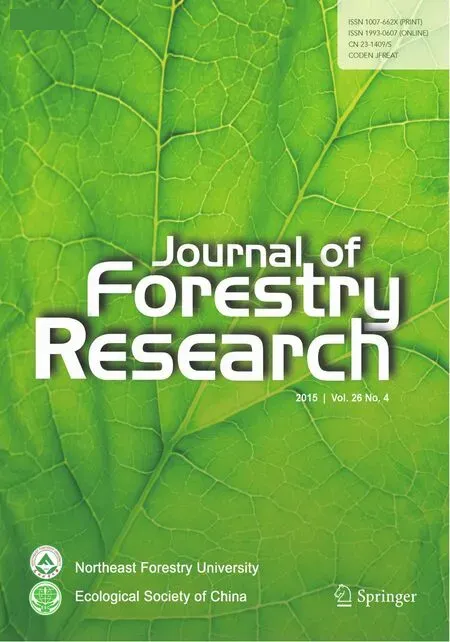 Journal of Forestry Research2015年4期
Journal of Forestry Research2015年4期
- Journal of Forestry Research的其它文章
- Drone remote sensing for forestry research and practices
- Life cycle environmental impact assessment of biochar-based bioenergy production and utilization in Northwestern Ontario, Canada
- Growth rates of Eucalyptus and other Australian native tree species derived from seven decades of growth monitoring
- Effect of f i rst thinning and pruning on the individual growth of Pinus patula tree species
- The inf l uence of selective cutting of mixed Korean pine(Pinus koraiensis Sieb.et Zucc.)and broad-leaf forest on rare species distribution patterns and spatial correlation in Northeast China
- Modeling forest f i res in Mazandaran Province,Iran
